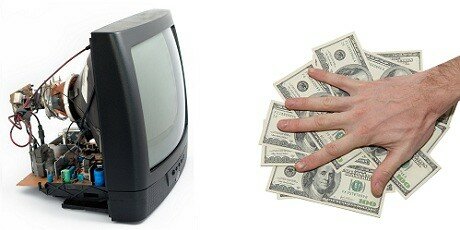
Deciphering CA CRT Regs: Consumer Fees Halved
There has been a lot of buzz about the recent emergency CRT Regulations in California. The DTSC has announced that, effective October 15, CRT (or Cathode Ray Tube) devices are eligible to be discarded in Class I landfills if a recycler proves that no other recycling option is feasible.
Naturally, environmental groups, recyclers, and concerned citizens all want to know what these new regulations mean and how we will be affected. Does landfilling these lead-containing devices, which has previously been prohibited, pose environmental and health risks? Will finite resources that could have otherwise been recovered (such as plastics, steel, and copper) be wasted as a result? For electronics recyclers, what constitutes proof that recycling options are not feasible? And will recyclers continue to be compensated by the state for recycling CRTs, even if "recycling" equates to dumping them in landfills? There is a lot of confusion, but one thing is certain - current CRT legislation paints a very unclear picture - reminiscent of the obsolete devices it was designed to regulate.
There is no doubt that stakeholders have a right to be concerned, but one issue doesn't seem to be getting any attention at all. There is an upside that has emerged out of the recent regulations: Californians will be paying less when they purchase new TVs and monitors.
As many of you know, California consumers bear the burden of funding the state electronics recycling program. When you purchase a new TV or monitor, you also pay a recycling fee of $6, $8, or $10 depending on the screen size. This money goes into the Covered Electronic Waste (CEW) program that reimburses authorized recyclers for properly managing the disposition of old electronic devices. This unique (and often criticized) program differs from other states' recycling programs in which the manufacturers bear the financial burden. However, the recent changes in California CRT regulations have cut the consumer fee in half, reducing it to $3, $4, and $5.
This reduction in consumer fees is most likely due to a budget surplus (or a projected surplus) in the state recycling program. The shrinking downstream markets for CRT glass (which prompted the DTSC's decision to allow landfill disposal in the first place) have also led to fewer recyclers submitting claims through the CEW payment program. With less money flowing out of the recycling program, the state had to decrease the funds flowing in. Thus, the reduction in fees charged to consumers.
Although this may seem insignificant in comparison to the fallout of allowing CRTs in landfills, it's something positive to take away from these regulations that have been the cause for so much confusion and frustration. You may recall that California retailers were enraged when the fees were initially introduced. Similarly, many consumers were opposed to the idea of paying for a service that was of no tangible consequence to them. Now, consumers and retailers can let go of their grief - or at least half of it. A 50% fee reduction is good news when you consider the fact that the electronics manufacturers are the ones that have to bite the bullet in other states.
But don’t get too excited. Those of you who are thinking about saving a few extra bucks on electronics this holiday season are going to be disappointed. According to CalRecycle, the reduction in consumer fees will not take effect until January 1, 2013. So if your budget is tight this year, you may want to refrain from buying that new flat screen for Christmas and wait until the Super Bowl instead.
Publication Date: 11/13/2012
